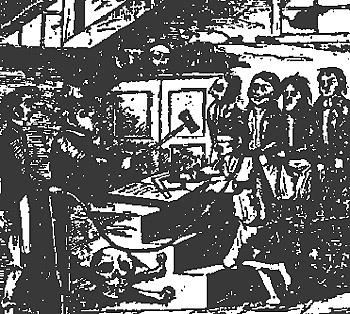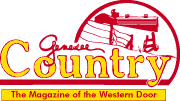
The
cover of the 1831 Anti-Masonic Almanac purports to depict the initiation of an
apprentice Mason, who was said to be threatened with mutilation and death if he
revealed the order's secrets. Image courtesy of J. Sheldon Fisher
Morgan
was taken, probably bound and gagged, to Rochester where he spent the night.
When a 52-year-old Batavia man borrowed a shirt and piece of neckwear from a Canandaigua
innkeeper in 1824, he unknowingly sealed his own fate, changed presidential politics
forever, and took the first step in what was to become the most famous murder
case in the first half of 19th century America.
William Morgan
was in most ways an unremarkable man, 5 feet 6 inches tall, with brown hair and
a high forehead. A veteran of the War of 1812, he claimed, inaccurately, that
he had received a battlefield commission from Andrew Jackson himself. He called
himself Capt. Morgan.
He was, in two ways, a Mason. He made
his livingwhen he worked, which was not oftenas a stonemason. The closest he
came to fame in that occupation was as the principle mason on the last home owned
by Col. Nathaniel Rochester, founder of the Genesee Country's largest city. That
home, on the corner of S. Washington and Spring streets, was built by Morgan in
1824 and torn down in 1908 to make room for a larger building.
Morgan
was also a member of the Freemasons, a secretive organization that grew out of
Europe's stonemason guilds during the Middle Ages. The first freemasonry lodge
was organized in 1717 in London; the New World's first Masonic lodge was formed
in Philadelphia in 1730. George Washington and a dozen other presidents were freemasons,
as were Benjamin Franklin and Rudyard Kipling.
In many ways
a fraternal organization, Freemasons mainly introduced members to one another.
In those days, they did a lot of drinking, and Morgan did more than most. The
Freemasons often enabled members to make useful business contacts, and Morgan
obtained jobs for stonemason work in Batavia and LeRoy.
The
Freemasons had a secret handshake, a secret organizational structure, and, their
most ardent enemies claimed, a secret plan to take over the world. They were a
politically cohesive group, and in some towns it was difficult to be elected to
local office if the Masons didn't like the candidate.
DeWitt
Clinton, governor of New York who a decade earlier had lost a close Presidential
election to James Madison, was among the nation's most prominent Freemasons.
Morgan
belonged to the LeRoy Masonic Lodge, but he wanted to also join a newly formed
lodge in Batavia. The decision on who could join was made by Masonic leaders in
Rochester, and they rejected Morgan's application because of his heavy drinking.
It was an odd charge, some of Morgan's friends felt, because many Freemasons were
known for their drinking.
Morgan was irate; the insult, particularly
after a few drinks in a Batavia tavern, was too much to endure. He took his complaint
to David Miller, editor of Batavia's, The Republican Advocate.
Miller,
once a Mason, had grown to distrust the organization. Miller was about to reprint
Jachin and Boaz, an out-of-print book that had exposed some Masonic secrets. Over
the centuries, there had been a dozen or more such books, and none of them were
much noticed. Morgan offered to write a new one, and Miller arranged for two Batavia
residents, Russell Dyer and John Davids, to finance the project.
So
in the spring of 1826, partly as an act of revenge for having been snubbed, and
partly as a shot at becoming a rich and famous author, Morgan began writing Illustrations
of Masonry By One of the Fraternity Who Has Devoted Thirty Years to the Subject.
Two years previously, Morgan's wife, Lucinda, 27 years his
junior, had given birth to a boy, and Morgan, staying at a Canandaigua tavern,
had accepted an offer from the tavern owner, David Kingsley, to borrow a clean
shirt and cravat so that he would be presentable visiting his newborn son. Morgan
eventually returned home to Batavia with his wife and son without returning Kingsley's
clothing.
Kingsley didn't mindat least not for two yearsbut
when word of Morgan's book-in-progress spread, he, like hundreds of other Masons
in New York, became irate. Rochester Masons, the regional leaders, were so angry
they sent Daniel John, a Canadian, to Batavia to spy on Morgan and Miller.

